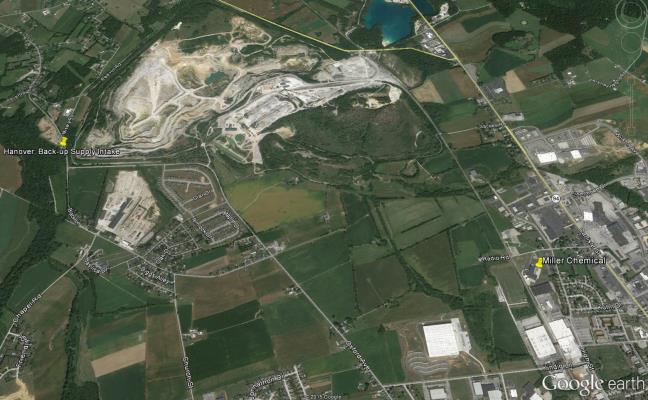Time-Of-Travel Tool Protects Drinking Water
Stories of Progress in Achieving Healthy Waters
U.S. EPA Region 3 Water Protection Division
Conewago Township, Pennsylvania • July 30, 2016
The Lower Susquehanna Source Water Protection (SWP) Partnership utilizes the Incident Command Tool for Drinking Water Protection (ICWater) to support the Pennsylvania Department of Environmental Protection (PADEP) with real-time spill tracking information to protect drinking water sources.
The ICWater tool is a geographic information system (GIS)-based model developed by the U.S. Geological Survey and EPA which provides real-time assessment of time-of-travel and contaminant dispersion in rivers and streams. With the support of CWA 106 funding, the Lower Susquehanna SWP Partnership has customized the model to include important source water information, including drinking water intake sites. The funding also enabled training of four ICWater operators to support the Susquehanna River Basin Early Warning System.
The tool was used to track contaminants from a chemical fire which occurred in the early morning hours of June 8, 2015 at the Miller Chemical and Fertilizer warehouse in Conewago Township near Hanover, PA. Miller Chemical, a nutritional agrochemical company, manufactures many water soluble fertilizers used for commercial agriculture. Polluted runoff from firefighting efforts reached Conewago Creek within a few hours.
The Susquehanna River Basin Commission has been developing the ICWater tool for five years, and in the past two years, the Lower Susquehanna SWP Partnership has committed to support the PADEP with spill tracking and time-of-travel estimates in emergency response.
A few hours after the Miller Chemical fire, responders realized that fire retardant foam and fertilizer compounds had washed into Slagle Run and posed a threat to water resources in Conewago Creek, the main source of drinking water for the New Oxford Municipal Authority.
At this time, the South Central Pennsylvania Emergency Response Team called upon the Partnership to run the ICWater model. Based on the model’s time-of-travel estimates, PADEP’s Emergency Response Team advised local drinking water utilities to close Conewago Creek intakes and use alternate supplies. Over the following days, the Partnership continued to run the model, supporting PADEP with updated information on estimated contaminant dispersion, which aided decision-making for downstream water supplies in Pennsylvania and Maryland.
The Lower Susquehanna SWP Partnership’s utilization of ICWater is an example of how EPA CWA funding can be leveraged to develop integrated tools that support the protection of drinking water resources, and how collaboration enhances comprehensive source water protection efforts.

- Time-Of-Travel Tool Protects Drinking Water (pdf) (618.83 KB, 07/30/2016)

AT A GLANCE
- The Lower Susquehanna Source Water Protection Partnership utilizes a Clean Water Act (CWA)-funded “time-of-travel tool” to support emergency response.
For additional information, contact:
Megan Keegan
Office of Drinking Water and Source Water Protection
U.S. Environmental Protection Agency
Region 3 Water Protection Division
1650 Arch Street
Philadelphia, PA 19103
[email protected]
